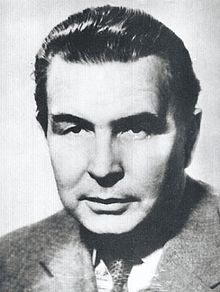This is an old revision of this page, as edited by A.S. Brown (talk | contribs) at 22:51, 3 June 2020 (Background and views). The present address (URL) is a permanent link to this revision, which may differ significantly from the current revision.
Revision as of 22:51, 3 June 2020 by A.S. Brown (talk | contribs) (Background and views)(diff) ← Previous revision | Latest revision (diff) | Newer revision → (diff)| This article includes a list of general references, but it lacks sufficient corresponding inline citations. Please help to improve this article by introducing more precise citations. (February 2010) (Learn how and when to remove this message) |

Adam Rapacki (24 December 1909 – 10 October 1970) was a Polish politician and diplomat
Biography
Rapacki was born in Lemberg, Austria-Hungary (modern Lviv, Ukraine) on 24 December 1909. He was a member of the Polish Socialist Party from 1945 to 1948 as well as its successor, the Polish United Workers' Party. He was also a member of the Politburo of the Central Committee up until 1968, on board as the minister of seafaring and the minister of higher education and research.
From 1956 to 1968, he was the foreign minister in the cabinet of Józef Cyrankiewicz. As a Foreign Minister, he was especially close to the director-general of the Foreign Ministry, Przemysław Ogrodziński, a man whose background as a socialist turned communist was precisely as same as his, and who served as his principle adviser. As a Foreign Minister, Rapacki was considered be one of the leaders of the liberalising wing of the United Workers' Party, known for favoring easing repression and censorship, which gave him a certain popularity.
On 2 October 1957, he presented at the United Nations his plan for a nuclear-free zone in Central Europe (comprising Czechoslovakia, Poland, East and West Germany) — known as the "Rapacki Plan".
Rapacki died in Warsaw, aged 60, on 10 October 1970.
See also
References
- ^ "Adam Rapacki". Encyclopædia Britannica. Retrieved 13 June 2013.
- ^ Wandcyz 1994, p. 294. sfn error: no target: CITEREFWandcyz1994 (help)
- Tobias Hochscherf; Christoph Laucht; Andrew Plowman (2010). Divided, But Not Disconnected: German Experiences of the Cold War. Berghahn Books. p. 100. ISBN 978-1-84545-646-7.
- Ruud van Dijk; William Glenn Gray; Svetlana Savranskaya; Jeremi Suri; Qiang Zhai (2013). Encyclopedia of the Cold War. Taylor & Francis. p. 373. ISBN 978-1-135-92311-2.
External links
- Nuclear-Weapon-Free Zones (NWFZ) At a Glance, Arms Control Association, July 2003.
Further reading
- Ozinga, James R., The Rapacki Plan: the 1957 Proposal to Denuclearize Central Europe, and an Analysis of Its Rejection, Jefferson, NC, McFarland & Co, 1989, ISBN 0-89950-445-0.
- Wandycz, Piotr (1994). "Adam Rapacki and the Search for European Security". The Diplomats, 1939-1979. Princeton: Princeton University Press. pp. 289–318. ISBN 0691194467.
{{cite book}}: Unknown parameter|editors=ignored (|editor=suggested) (help)
This biographical article about a Polish politician is a stub. You can help Misplaced Pages by expanding it. |
- 1909 births
- 1970 deaths
- People from Lviv
- People from the Kingdom of Galicia and Lodomeria
- Polish Austro-Hungarians
- Polish Socialist Party politicians
- Members of the Politburo of the Polish United Workers' Party
- Ministers of Foreign Affairs of Poland
- Members of the Polish Sejm 1947–1952
- Members of the Polish Sejm 1952–1956
- Members of the Polish Sejm 1957–1961
- Members of the Polish Sejm 1961–1965
- Members of the Polish Sejm 1965–1969
- Diplomats of the Polish People's Republic
- Recipients of the Order of the Builders of People's Poland
- Polish politician stubs